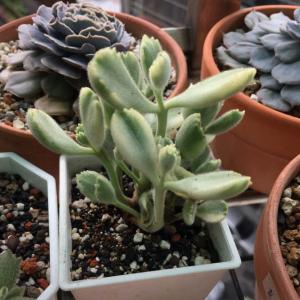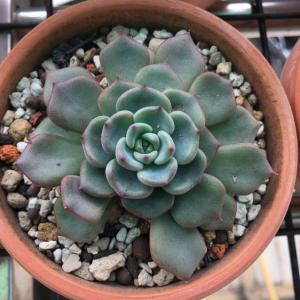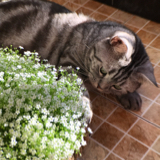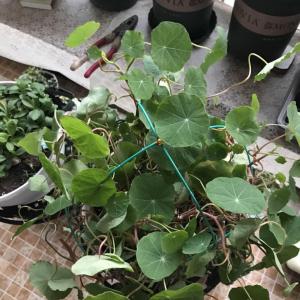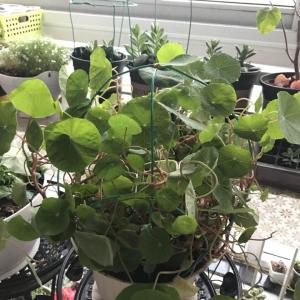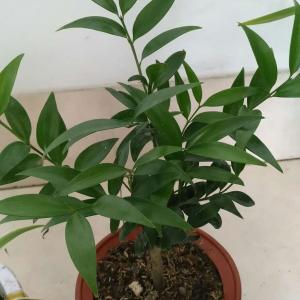文章
Miss Chen
2018年01月22日

Description: This perennial wildflower is 1-2½' tall and compactly branched. The stems are light green to reddish green, angular or terete, and canescent-hairy. Alternate compound leaves occur along the stems; individual leaves are palmate with 7-11 leaflets. Individual leaflets are 1-2½" long and oblanceolate in shape; their margins are smooth and ciliate. The upper surface of the leaflets is medium green and hairless, while the lower surface is pale green. Each compound leaf has a long ascending petiole about 1-4" long that is light green to reddish green. The stems, petioles, and leaf undersides are sparsely to moderately canescent-hairy. The upper stems terminate in narrow racemes of flowers about 4-10" long. The flowering stalks are light green to reddish purple. Individual flowers are about ¾" long, consisting of 5 blue-violet petals (rarely white or pink), a tubular calyx with large lobes, several stamens, and a pistil with a single style. The petals have a pea-like floral structure, consisting of a large upper banner and 2 wings that project forward to enclose the keel. The lateral edges of the banner fold backward from its center; as a flower ages, the center of the banner becomes more white. The calyx is light green to reddish purple. The slender pedicels of the flowers are up to ½" long. The flowering stalks, calyces, and pedicels are sparsely to moderately canescent-hairy. At the base of each flower, there is a linear-lanceolate floral bract that soon withers away.
The blooming period occurs from late spring to early summer and lasts about 1 month for a colony of plants. Afterwards, the flowers are replaced by elongated seedpods about 1¼-2" long and canescent-hairy. Each seedpod contains about 7 seeds, which can be ejected several feet away from the mother plant. The root system consists of a taproot with rhizomes. Reproduction is by seed and vegetative clones from the rhizomes.
Cultivation: The preference is full or partial sun, mesic to dry conditions, and an acidic soil containing sand or sandy loam. The root system can fix nitrogen into the soil. The seeds should be scarified to facilitate germination. Individual plants can be short-lived or long-lived, depending on environmental conditions.
Range & Habitat: Wild Lupine is an uncommon native wildflower that is found in NE Illinois and other northern areas of the state (see Distribution Map). Because of habitat destruction and fire suppression, populations of this wildflower have declined. Habitats include sand prairies, openings in sandy woodlands, sandy savannas, edges of sandy woodlands, stabilized sand dunes, and powerline clearances in sandy areas. Dominant canopy trees in some of these habitats are either oaks (especially Black Oak) or pines.

Faunal Associations: The flowers are cross-pollinated primarily by honeybees, bumblebees, digger bees (Synhalonia spp.), Mason bees (Osmia spp.), and other long-tongued bees. Other floral visitors include Halictid bees and bee flies. Only pollen is available as a floral reward, which is forcibly ejected into the faces of such insect visitors. Occasionally, the Karner Blue and other butterflies visit the flowers, searching in vain for nectar. Several insects feed on the foliage and other parts of Wild Lupine. These insect feeders include caterpillars of the butterflies Lycaeides melissa samuelis (Karner Blue) and Callophrys irus (Frosted Elfin), and caterpillars of the skippers Erynnis baptisiae (Wild Indigo Duskywing) and Erynnis persius (Persius Duskywing). The caterpillars of several moths also feed on Wild Lupine: Caenurgina crassiuscula (Clover Looper), Grammia phyllira (Phyllira Tiger Moth), Grammia placentia (Placentia Tiger Moth), Utetheisa bella (Bella Moth), and Walshia miscecolorella (Sweet Clover Root Borer). Other insects feeders include Empoasca fabae (Potato Leafhopper), Hadronema militaris (Military Plant Bug), and seed-eating larvae of the weevil Apion minor. The foliage is toxic to sheep and horses, however deer, rabbits, and woodchucks occasionally browse on Wild Lupine.

Photographic Location: A wooded sand dune at the Indiana Dunes State Park in NW Indiana.
Comments: This is the only lupine that is native to Illinois; species in this genus are more abundant in the western United States. Wild Lupine is readily distinguished from Baptisia spp. (Wild Indigos) and other similar species in the Bean family by the abundant leaflets of its palmate leaves (7-11 per leaf). Other similar species in Illinois have either trifoliate leaves (3 leaflets per compound leaf) or pinnate compound leaves. Both the flowers and foliage of Wild Lupine are quite attractive. Another common name of this species is Sundial Lupine, because the palmate leaves orient themselves in the direction of the sun.
The blooming period occurs from late spring to early summer and lasts about 1 month for a colony of plants. Afterwards, the flowers are replaced by elongated seedpods about 1¼-2" long and canescent-hairy. Each seedpod contains about 7 seeds, which can be ejected several feet away from the mother plant. The root system consists of a taproot with rhizomes. Reproduction is by seed and vegetative clones from the rhizomes.
Cultivation: The preference is full or partial sun, mesic to dry conditions, and an acidic soil containing sand or sandy loam. The root system can fix nitrogen into the soil. The seeds should be scarified to facilitate germination. Individual plants can be short-lived or long-lived, depending on environmental conditions.
Range & Habitat: Wild Lupine is an uncommon native wildflower that is found in NE Illinois and other northern areas of the state (see Distribution Map). Because of habitat destruction and fire suppression, populations of this wildflower have declined. Habitats include sand prairies, openings in sandy woodlands, sandy savannas, edges of sandy woodlands, stabilized sand dunes, and powerline clearances in sandy areas. Dominant canopy trees in some of these habitats are either oaks (especially Black Oak) or pines.

Faunal Associations: The flowers are cross-pollinated primarily by honeybees, bumblebees, digger bees (Synhalonia spp.), Mason bees (Osmia spp.), and other long-tongued bees. Other floral visitors include Halictid bees and bee flies. Only pollen is available as a floral reward, which is forcibly ejected into the faces of such insect visitors. Occasionally, the Karner Blue and other butterflies visit the flowers, searching in vain for nectar. Several insects feed on the foliage and other parts of Wild Lupine. These insect feeders include caterpillars of the butterflies Lycaeides melissa samuelis (Karner Blue) and Callophrys irus (Frosted Elfin), and caterpillars of the skippers Erynnis baptisiae (Wild Indigo Duskywing) and Erynnis persius (Persius Duskywing). The caterpillars of several moths also feed on Wild Lupine: Caenurgina crassiuscula (Clover Looper), Grammia phyllira (Phyllira Tiger Moth), Grammia placentia (Placentia Tiger Moth), Utetheisa bella (Bella Moth), and Walshia miscecolorella (Sweet Clover Root Borer). Other insects feeders include Empoasca fabae (Potato Leafhopper), Hadronema militaris (Military Plant Bug), and seed-eating larvae of the weevil Apion minor. The foliage is toxic to sheep and horses, however deer, rabbits, and woodchucks occasionally browse on Wild Lupine.

Photographic Location: A wooded sand dune at the Indiana Dunes State Park in NW Indiana.
Comments: This is the only lupine that is native to Illinois; species in this genus are more abundant in the western United States. Wild Lupine is readily distinguished from Baptisia spp. (Wild Indigos) and other similar species in the Bean family by the abundant leaflets of its palmate leaves (7-11 per leaf). Other similar species in Illinois have either trifoliate leaves (3 leaflets per compound leaf) or pinnate compound leaves. Both the flowers and foliage of Wild Lupine are quite attractive. Another common name of this species is Sundial Lupine, because the palmate leaves orient themselves in the direction of the sun.
0
0
文章
Miss Chen
2018年01月22日


野姜花又名姜花,是姜科野姜花属的淡水草本植物,高1-2米,花序为穗状,花萼管状,叶序互生,叶片长狭,两端尖,叶面秃,叶背略带薄毛。不耐寒,喜冬季温暖、夏季湿润环境,抗旱能力差,生长初期宜半阴,生长旺盛期需充足阳光。土壤宜肥沃,保湿力强。野姜花有清新的香味,放于室内可作天然的空气清新器。色泽圆融,一般为白色花朵。盆栽可供观赏,白色花卉如蝴蝶,所以又称蝴蝶姜、白蝴蝶花等。原产亚洲热带,印度和马来西亚的热带地区,大概在清代传入中国。另外,野姜花是古巴和尼加拉瓜的国花。
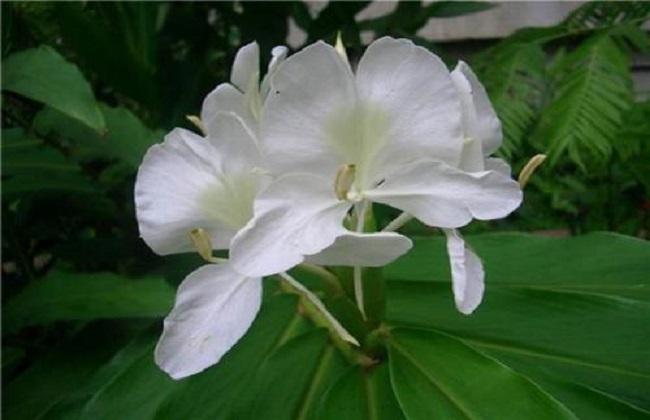
一、野姜花的生长习性
野姜花是一种淡水草本植物,花朵清新优雅,香气芬芳,是一种十分优良的天然空气清新剂,同时也能作为观赏花卉培育。由于野姜花原产自热带地区,因此比较喜欢高温、高湿的环境,不耐寒。
二、野姜花的养殖方法
1.温度和土壤
因为野姜花本身喜好高温以及高湿的环境,所以要保证生长环境的温度,一般冬天的温度只保持在10℃以上即可。
野姜花对于土壤的要求就是要选择疏松性、排水性良好的肥沃砂质土壤才可以保证其生长所需的营养。
2.水分
野姜花是一种不耐旱的植株,所以在夏季干旱炎热的时候要保持湿润的环境,也要土壤要保持湿润,还要经常往叶子上喷洒水分,保持叶子的湿度。
3.施肥
野姜花在种植的时候就要施基肥,这时可选择一些有生物菌肥,机肥以及磷肥等肥料当作基肥,再施到盆里;等到生长期要适当的进行追肥,大概每隔10天进行一次追肥即可,也要经常在阴雨天向叶面喷洒叶面肥。
三、野姜花养殖的注意事项
1.冬季温度
冬季的时候要注意温度要保持在10℃以上,以免冻伤。平时也要保证高温多湿。
2.光照强度
野姜花喜好温暖,所以在生长期可以保持足够的光照,使野姜花能够更好的生长。
3.施肥频率
野姜花的施肥频率主要是要注意生长期的施肥时间和次数,生长期通常每10天施一次肥,时间一般选择在晴朗的早晨为宜。
以上就是为大家带来的野姜花的养殖方法和注意事项的介绍,野姜花除了能净化空气外,它的根茎果实还是一种良好的中药材,野姜花本身又是一种良好的观赏花卉,还能在插花中作为切花使用,更是一种绿色保健的食用蔬菜,可谓一花多用,喜欢的朋友不妨在家中种上几朵哟!
0
0
文章
Miss Chen
2018年01月21日

Description: This perennial wildflower is 1-2½' tall and usually unbranched, except toward the apex where the flowers occur. Often a cluster of leafy stems originate from the same taproot. The rather stout stems are light green, very hairy, and either terete or shallowly grooved. Along each stem, there are 12 or more alternate leaves that are ascending to widely spreading. Individual leaves are 1½-3" long, ¼-¾" across, pale green to dark green, and sessile; they are narrowly lanceolate to lanceolate with margins that are toothless and ciliate. Both the upper and lower surfaces of the leaves are hairy.
The upper stems terminate in curved racemes of flowers, forming together a flat-headed cluster of flowers. Each flower is about ¾" across, consisting of a yellow to orange-yellow corolla with 5 large rounded lobes, a green hairy calyx with 5 linear-lanceolate teeth, 5 inserted stamens, and a pistil with an inserted style. The tubular corolla has a narrow throat with widely spreading lobes; it is minutely hairy just below the opening of the throat. On some plants, the flowers have long stamens and short styles, while the flowers of other plants have short stamens and long styles. The blooming period occurs from late spring to mid-summer, lasting about 4 weeks. There is no noticeable floral scent. Afterwards, each flower is replaced by 4 shiny white nutlets (or sometimes fewer) that are visible from above. They are distributed by gravity and usually remain near the mother plant. The root system consists of a short stout taproot that is red to reddish purple. This wildflower reproduces by reseeding itself.
Cultivation: The preference is full or partial sun, dry-mesic to dry conditions, and sandy soil. Because the nutlets are difficult to germinate and transplants often fail, this wildflower is not widely available from nurseries, and as a result it is rarely cultivated.

Range & Habitat: The native Hairy Puccoon is occasional in sandy areas of central and northern Illinois, while in the rest of the state it is rare or absent (see Distribution Map). Habitats include open sandy woodlands, sandy savannas, upland sand prairies, sandy hill prairies, sand dunes along Lake Michigan, and sandy embankments along roads and railroads. Occasional disturbance from wildfires and other sources is beneficial if it reduces competition from woody vegetation.
Faunal Associations: The showy flowers are cross-pollinated by such butterflies and skippers as Lycaeides melissa samuelis (Karner Blue) and Poanes hobomok (Hobomok Skipper). The larvae of a long-horned beetle, Hemierana marginata ardens, feed on native Lithospermum spp. (puccoons), probably by boring through the stems or roots. The adults of this beetle mimic fireflies (Lampyridae), probably because of the latter's unpalatability to birds and other predators. The caterpillars of Ethmia longimaculella (Streaked Ethmia Moth) and Ethmia fuscipedella (Gray Ethmia Moth) are known to feed on native puccoons as well. The latter moth is also referred to as Ethmia monticola fuscipedella. White-Tailed Deer occasionally browse on Hairy Puccoon.

Photographic Location: A sandy savanna at the Oak Openings Nature Preserve in NW Ohio, and a stabilized sand dune with scattered oak trees at the Indiana Dunes State Park in NW Indiana.
Comments: The flowers of this wildflower are very showy and brilliantly colored – they can be seen from a considerable distance. Hairy Puccoon is one of three native puccoons (Lithospermum spp.) in Illinois. It can be distinguished from Hoary Puccoon (Lithospermum canescens) by its larger flowers, rough hairs on its foliage, and somewhat greater height. Hoary Puccoon has an abundance of hairs on its foliage, but they have a softer texture. The remaining native species, Fringed Puccoon (Lithospermum incisum), has flowers with fringed lobes, rather than rounded lobes. This latter species also has more narrow leaves. There are some Lithospermum spp. from Eurasia in Illinois, but none of them have the showy yellow to orange-yellow flowers of the native puccoons. Sometimes the scientific name of Hairy Puccoon is spelled Lithospermum carolinense. The specimens of Hairy Puccoon in Illinois (and Ohio) are considered examples of a northern variety of this species, Lithospermum caroliniense croceum. Some authors (e.g., Mohlenbrock, 2014) prefer to treat this variety as a distinct species, Lithospermum croceum, but this viewpoint is not widely accepted at the present time.
The upper stems terminate in curved racemes of flowers, forming together a flat-headed cluster of flowers. Each flower is about ¾" across, consisting of a yellow to orange-yellow corolla with 5 large rounded lobes, a green hairy calyx with 5 linear-lanceolate teeth, 5 inserted stamens, and a pistil with an inserted style. The tubular corolla has a narrow throat with widely spreading lobes; it is minutely hairy just below the opening of the throat. On some plants, the flowers have long stamens and short styles, while the flowers of other plants have short stamens and long styles. The blooming period occurs from late spring to mid-summer, lasting about 4 weeks. There is no noticeable floral scent. Afterwards, each flower is replaced by 4 shiny white nutlets (or sometimes fewer) that are visible from above. They are distributed by gravity and usually remain near the mother plant. The root system consists of a short stout taproot that is red to reddish purple. This wildflower reproduces by reseeding itself.
Cultivation: The preference is full or partial sun, dry-mesic to dry conditions, and sandy soil. Because the nutlets are difficult to germinate and transplants often fail, this wildflower is not widely available from nurseries, and as a result it is rarely cultivated.

Range & Habitat: The native Hairy Puccoon is occasional in sandy areas of central and northern Illinois, while in the rest of the state it is rare or absent (see Distribution Map). Habitats include open sandy woodlands, sandy savannas, upland sand prairies, sandy hill prairies, sand dunes along Lake Michigan, and sandy embankments along roads and railroads. Occasional disturbance from wildfires and other sources is beneficial if it reduces competition from woody vegetation.
Faunal Associations: The showy flowers are cross-pollinated by such butterflies and skippers as Lycaeides melissa samuelis (Karner Blue) and Poanes hobomok (Hobomok Skipper). The larvae of a long-horned beetle, Hemierana marginata ardens, feed on native Lithospermum spp. (puccoons), probably by boring through the stems or roots. The adults of this beetle mimic fireflies (Lampyridae), probably because of the latter's unpalatability to birds and other predators. The caterpillars of Ethmia longimaculella (Streaked Ethmia Moth) and Ethmia fuscipedella (Gray Ethmia Moth) are known to feed on native puccoons as well. The latter moth is also referred to as Ethmia monticola fuscipedella. White-Tailed Deer occasionally browse on Hairy Puccoon.

Photographic Location: A sandy savanna at the Oak Openings Nature Preserve in NW Ohio, and a stabilized sand dune with scattered oak trees at the Indiana Dunes State Park in NW Indiana.
Comments: The flowers of this wildflower are very showy and brilliantly colored – they can be seen from a considerable distance. Hairy Puccoon is one of three native puccoons (Lithospermum spp.) in Illinois. It can be distinguished from Hoary Puccoon (Lithospermum canescens) by its larger flowers, rough hairs on its foliage, and somewhat greater height. Hoary Puccoon has an abundance of hairs on its foliage, but they have a softer texture. The remaining native species, Fringed Puccoon (Lithospermum incisum), has flowers with fringed lobes, rather than rounded lobes. This latter species also has more narrow leaves. There are some Lithospermum spp. from Eurasia in Illinois, but none of them have the showy yellow to orange-yellow flowers of the native puccoons. Sometimes the scientific name of Hairy Puccoon is spelled Lithospermum carolinense. The specimens of Hairy Puccoon in Illinois (and Ohio) are considered examples of a northern variety of this species, Lithospermum caroliniense croceum. Some authors (e.g., Mohlenbrock, 2014) prefer to treat this variety as a distinct species, Lithospermum croceum, but this viewpoint is not widely accepted at the present time.
0
0
文章
Miss Chen
2018年01月21日

Description: This perennial plant is about ½-1½' tall, sending up one or more leafy stems from the same root system. These stems are erect to ascending; they are unbranched below, while branching occasionally above. Individual stems are light green, terete, and hairy; these hairs are white and spreading. Alternate leaves occur along the entire length of each stem, differing little in size. These leaves are 1–1¾" long and ¼–½" across with prominent central veins; they are oblong or elliptic in shape, while their margins are entire (toothless) and ciliate. The leaf bases are sessile, while the leaf tips are bluntly acute to rounded. The upper leaf surfaces are medium to dark green and sparsely to moderately covered with short appressed hairs. The lower leaf surfaces are light to medium green and sparsely to densely pubescent; hairs are usually more common along the lower side of their central veins. The white hairs and pubescence of this plant provide it with a slightly hoary appearance, hence the common name. The upper stems terminate in showy clusters of flowers. Initially these flowers are arranged along short curled racemes, but somewhat later these racemes become longer and more erect.
Each flower spans about ½" across, consisting of a bright yellow to orange-yellow corolla with 5 lobes, a light green calyx with 5 long teeth, 5 stamens, and a 4-chambered pistil with a single style. The lobes of the corolla are rounded and spreading, while the base of the corolla is narrowly tubular and slightly funnelform. Both the calyx and its teeth are hairy; the teeth are linear-lanceolate in shape and up to ¼" long. The reproductive organs of this plant are heterostylous: some flowers have long styles and stamens with short filaments, while other flowers have short styles and stamens with long filaments. The pedicels of the flowers are very short (less than 3 mm. long). The blooming period occurs from mid-spring to early summer, lasting about 1 month for a colony of plants. Afterwards, the flowers are replaced by nutlets (4 nutlets per flower). Mature nutlets are 2-3 mm. long and ovoid in shape with pointed tips; their surfaces are hard, white, smooth, and shiny. The root system consists of a taproot. This plant reproduces by reseeding itself.

Cultivation: The preference is full sun, mesic to dry conditions, and soil containing loam, rocky material, or sand. The seeds of Hoary Puccoon are notoriously difficult to germinate, and its root system (consisting of a taproot) is not readily divided. As a result, this plant is rarely cultivated. This is a pity, because the flowers are very showy.
Range & Habitat: The native Hoary Puccoon occurs throughout Illinois, except in some SE areas of the state (see Distribution Map). This conservative plant is occasional in high quality natural areas (primarily upland prairies and savannas), otherwise it is rare or absent. Habitats include black soil prairies, sand prairies, hill prairies, upland savannas, sandy Black Oak savannas, and limestone glades. This is the most common and widely distributed species of its genus in Illinois.

Faunal Associations: The flowers attract bumblebees, digger bees (Synhalonia spp.), cuckoo bees (Nomada spp.), mason bees (Osmia spp.), bee flies (Bombylius spp.), butterflies (Vanessa spp., Papilio spp.), skippers (Erynnis spp.), and other insects (Robertson, 1929; Reed, 1993; Macior, 1967). The larvae of a long-horned beetle, Hemierana marginata ardens, feeds on Lithospermum spp., probably by boring through the stems and/or roots (Yanega, 1996). Because the foliage of Hoary Puccoon contains pyrrolizidine alkaloids, it can be considered more or less toxic to many herbivores (e.g., insects and mammals). There is some evidence, however, that this plant becomes relatively more abundant when White-tailed Deer and other mammalian herbivores are excluded from its proximity by fences (Ritchie et al., 1998). This implies that the foliage of Hoary Puccoon is probably grazed by White-tailed Deer and possibly other mammalian herbivores, notwithstanding its known toxicity.

Photographic Location: The photographs were taken at Loda Cemetery Prairie in Iroquois County, Illinois, and a hill prairie in McLean County, Illinois.
Comments: Because Hoary Puccoon (Lithospermum canescens) begins to bloom during the spring when other ground vegetation is relatively low, the brightly colored flowers can be seen from a distance. The word 'puccoon' means that this plant was the source of a dye at one time – a reddish color that was used by Amerindians for pottery, basketry, and personal ornament in various ceremonies. Hoary Puccoon is one of three native puccoon species (Lithospermum spp.) in Illinois that have flowers with bright yellow or yellow-orange corollas. Unlike Fringed Puccoon (Lithospermum incisum), the corolla lobes of Hoary Puccoon are smooth, rather than fringed, and it has wider leaves (exceeding ¼" across). Compared to Hairy Puccoon (Lithospermum croceum), Hoary Puccoon is a smaller plant with smaller flowers – it also blooms earlier in the year. Unlike the preceding two species, the corollas of Hoary Puccoon are sometimes yellow-orange, rather than yellow.
Each flower spans about ½" across, consisting of a bright yellow to orange-yellow corolla with 5 lobes, a light green calyx with 5 long teeth, 5 stamens, and a 4-chambered pistil with a single style. The lobes of the corolla are rounded and spreading, while the base of the corolla is narrowly tubular and slightly funnelform. Both the calyx and its teeth are hairy; the teeth are linear-lanceolate in shape and up to ¼" long. The reproductive organs of this plant are heterostylous: some flowers have long styles and stamens with short filaments, while other flowers have short styles and stamens with long filaments. The pedicels of the flowers are very short (less than 3 mm. long). The blooming period occurs from mid-spring to early summer, lasting about 1 month for a colony of plants. Afterwards, the flowers are replaced by nutlets (4 nutlets per flower). Mature nutlets are 2-3 mm. long and ovoid in shape with pointed tips; their surfaces are hard, white, smooth, and shiny. The root system consists of a taproot. This plant reproduces by reseeding itself.

Cultivation: The preference is full sun, mesic to dry conditions, and soil containing loam, rocky material, or sand. The seeds of Hoary Puccoon are notoriously difficult to germinate, and its root system (consisting of a taproot) is not readily divided. As a result, this plant is rarely cultivated. This is a pity, because the flowers are very showy.
Range & Habitat: The native Hoary Puccoon occurs throughout Illinois, except in some SE areas of the state (see Distribution Map). This conservative plant is occasional in high quality natural areas (primarily upland prairies and savannas), otherwise it is rare or absent. Habitats include black soil prairies, sand prairies, hill prairies, upland savannas, sandy Black Oak savannas, and limestone glades. This is the most common and widely distributed species of its genus in Illinois.

Faunal Associations: The flowers attract bumblebees, digger bees (Synhalonia spp.), cuckoo bees (Nomada spp.), mason bees (Osmia spp.), bee flies (Bombylius spp.), butterflies (Vanessa spp., Papilio spp.), skippers (Erynnis spp.), and other insects (Robertson, 1929; Reed, 1993; Macior, 1967). The larvae of a long-horned beetle, Hemierana marginata ardens, feeds on Lithospermum spp., probably by boring through the stems and/or roots (Yanega, 1996). Because the foliage of Hoary Puccoon contains pyrrolizidine alkaloids, it can be considered more or less toxic to many herbivores (e.g., insects and mammals). There is some evidence, however, that this plant becomes relatively more abundant when White-tailed Deer and other mammalian herbivores are excluded from its proximity by fences (Ritchie et al., 1998). This implies that the foliage of Hoary Puccoon is probably grazed by White-tailed Deer and possibly other mammalian herbivores, notwithstanding its known toxicity.

Photographic Location: The photographs were taken at Loda Cemetery Prairie in Iroquois County, Illinois, and a hill prairie in McLean County, Illinois.
Comments: Because Hoary Puccoon (Lithospermum canescens) begins to bloom during the spring when other ground vegetation is relatively low, the brightly colored flowers can be seen from a distance. The word 'puccoon' means that this plant was the source of a dye at one time – a reddish color that was used by Amerindians for pottery, basketry, and personal ornament in various ceremonies. Hoary Puccoon is one of three native puccoon species (Lithospermum spp.) in Illinois that have flowers with bright yellow or yellow-orange corollas. Unlike Fringed Puccoon (Lithospermum incisum), the corolla lobes of Hoary Puccoon are smooth, rather than fringed, and it has wider leaves (exceeding ¼" across). Compared to Hairy Puccoon (Lithospermum croceum), Hoary Puccoon is a smaller plant with smaller flowers – it also blooms earlier in the year. Unlike the preceding two species, the corollas of Hoary Puccoon are sometimes yellow-orange, rather than yellow.
0
0





